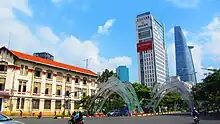 Ham Nghi Boulevard in 2014 | |
| Native name | Đường Hàm Nghi, Đại lộ Hàm Nghi (Vietnamese) |
|---|---|
| Former name(s) | Boulevard de Canton, Boulevard de la Somme |
| Owner | Ho Chi Minh City |
| Location | District 1, Ho Chi Minh City |
| Nearest metro station | Ben Thanh metro station |
| Coordinates | 10°46′15″N 106°42′11″E / 10.770963°N 106.703008°E |
| East end | Tôn Đức Thắng Boulevard |
| Major junctions | Hồ Tùng Mậu Street Tôn Thất Đạm Street Pasteur Street Nam Kỳ Khởi Nghĩa Street Phó Đức Chính Street |
| West end | Quách Thị Trang Square |
Hàm Nghi Boulevard (Vietnamese: Đường Hàm Nghi) is an east–west boulevard in District 1, downtown Ho Chi Minh City, Vietnam.[1] The boulevard stretches from Tôn Đức Thắng Boulevard (Bạch Đằng Quay, Saigon River waterfront) to the Quách Thị Trang Square (in front of the Bến Thành Market).[2]
History
The boulevard was originally a waterway known in Vietnamese as rạch Cầu Sấu (translating to "Crocodile Bridge creek"). According to scholar Pétrus Ký, the creek got its name as there was once a crocodile reservoir in the area, where crocodiles were bred for meat.[3]
Following the French conquest of Saigon, the streets on both sides of the creek were first designated by n° 3, then they were given the names rue Dayot and rue de Canton, respectively. The waterway was later filled in and then by a decree dated 14 May 1877, the two streets were given a single name: boulevard de Canton. In the 1880s, the Saigon–My Tho railway line was built along the center of the boulevard. On 24 February 1897, the municipal council decided to split the boulevard into two separate streets on either side of the railway track, each named after a French admiral: rue Krantz on the northern side and rue Duperré on the southern side. Then again on 22 April 1920, after the relocation of the railway terminus to the area occupied today by September 23 Park, the municipal council decided to resume the name "boulevard" for the streets, and the name boulevard de la Somme was chosen, after the Battle of the Somme, one of the First World War's deadliest battles.[4][5][6]
In 1955, the boulevard was renamed Hàm Nghi Boulevard by the government South Vietnam, after the former Emperor Hàm Nghi of the Nguyễn dynasty.[7][8]
References
- ↑ "Map of Ho Chi Minh City". HCM CityWeb. Archived from the original on 2021-12-11. Retrieved 2023-10-17.
- ↑ Bao Anh; Duc Phu (July 19, 2022). "Ho Chi Minh City plans expansion of downtown pedestrian streets". Tuoi Tre News. Archived from the original on October 20, 2023. Retrieved October 17, 2023.
- ↑ Trương, Jean Baptiste Pétrus Vĩnh Ký (1885). Souvenirs historiques sur Saïgon et ses environs: conférence faite au collège des interprètes. Saigon: Imprimerie coloniale. p. 18. Archived from the original on 2022-07-09. Retrieved 2023-10-17.
- ↑ Baudrit, André (1943). Guide historique des rues de Saigon. Saigon: S.I.L.I. p. 418. Archived from the original on 2023-11-03. Retrieved 2023-10-30.
- ↑ Doling, Tim (7 December 2015). "Saigon's Famous Streets and Squares: Ham Nghi Boulevard, Part 1". Saigoneer. Archived from the original on 17 October 2023. Retrieved 17 October 2023.
- ↑ Doling, Tim (8 December 2015). "Saigon's Famous Streets and Squares: Ham Nghi Boulevard, Part 2". Saigoneer. Archived from the original on 17 October 2023. Retrieved 17 October 2023.
- ↑ Corfield, Justin (2014). Historical Dictionary of Ho Chi Minh City. Anthem Press. p. 360. Archived from the original on 2023-10-22. Retrieved 2023-10-30.
- ↑ Guillaume, Xavier; Guillaume, Marie-Christine (2004). La Terre du Dragon – Tome I. Paris: Publibook. p. 58. Archived from the original on 2023-11-10. Retrieved 2023-10-30.
See also